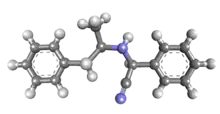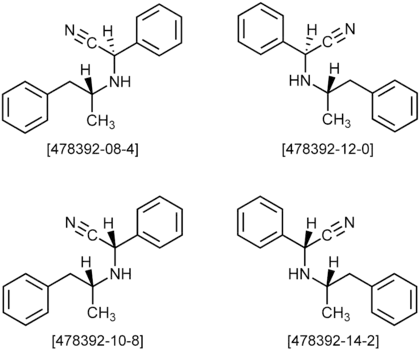Amfetaminil
 | |
 | |
| Clinical data | |
|---|---|
| ATC code |
|
| Legal status | |
| Legal status |
|
| Identifiers | |
IUPAC name
| |
| CAS Number | |
| PubChem CID | |
| ChemSpider | |
| UNII | |
| KEGG | |
| ChEMBL | |
| ECHA InfoCard | 100.037.767 |
| Chemical and physical data | |
| Formula | C17H18N2 |
| Molar mass | 250.338 g·mol−1 |
| 3D model (JSmol) | |
SMILES
| |
InChI
| |
| | |
Amfetaminil (also known as amphetaminil, N-cyanobenzylamphetamine,[1] and AN-1; brand name Aponeuron) is a stimulant drug derived from amphetamine, which was developed in the 1970s and used for the treatment of obesity,[2] ADHD,[3][4] and narcolepsy.[5] It has largely been withdrawn from clinical use following problems with abuse.[6] The drug is a prodrug to amphetamine.[7][8]
Stereochemistry
Amfetaminil is a molecule with two stereogenic centers. Thus, four different stereoisomers exist:

- (R)-2-[(R)-1-Phenylpropan-2-ylamino]-2-phenylacetonitrile (CAS number 478392-08-4)
- (S)-2-[(S)-1-Phenylpropan-2-ylamino]-2-phenylacetonitrile (CAS number 478392-12-0)
- (R)-2-[(S)-1-Phenylpropan-2-ylamino]-2-phenylacetonitrile (CAS number 478392-10-4)
- (S)-2-[(R)-1-Phenylpropan-2-ylamino]-2-phenylacetonitrile (CAS number 478392-14-2)
References
- ↑ Morton IK, Hall JM (6 December 2012). Concise Dictionary of Pharmacological Agents: Properties and Synonyms. Springer Science & Business Media. pp. 13–. ISBN 978-94-011-4439-1.
- ↑ Harris LS (June 1986). "The stimulants and hallucinogens under consideration: a brief overview of their chemistry and pharmacology". Drug and Alcohol Dependence. 17 (2–3): 107–18. doi:10.1016/0376-8716(86)90002-5. PMID 2874966.
- ↑ Meyer-Probst B, Vehreschild T (August 1976). "[Influencing the lack of concentration in hyperkinetic school children with Aponeuron]". Psychiatrie, Neurologie, und Medizinische Psychologie (in German). 28 (8): 491–9. PMID 1005547.
- ↑ Paclt I, Florian J, Brunclíková J, Růzicková I (May 1996). "[Effect of Aponeuron in the treatment of children with hyperkinetic syndrome]". Ceska a Slovenska Psychiatrie (in Czech). 92 Suppl 1: 41–57. PMID 8768943.
- ↑ Schlesser JL (1991). Drugs Available Abroad - A Guide to Therapeutic Drugs Approved Outside the US. Detroit: MEDEX Books.
- ↑ Winter E (September 1976). "[Drug abuse and dependence of the amphetamine type with special regard to Amphetaminil (Aponeuron(R))]". Psychiatrie, Neurologie, und Medizinische Psychologie (in German). 28 (9): 513–25. PMID 1005549.
- ↑ Dasgupta A (2 July 2012). Resolving Erroneous Reports in Toxicology and Therapeutic Drug Monitoring: A Comprehensive Guide. John Wiley & Sons. pp. 96–. ISBN 978-1-118-34785-0.
- ↑ AHC Media, LLC (17 March 2014). Pediatric Trauma Care II: A clinical reference for physicians and nurses caring for the acutely injured child. AHC Media, LLC. pp. 118–. ISBN 978-1-934863-59-6.
This article is issued from Offline. The text is licensed under Creative Commons - Attribution - Sharealike. Additional terms may apply for the media files.